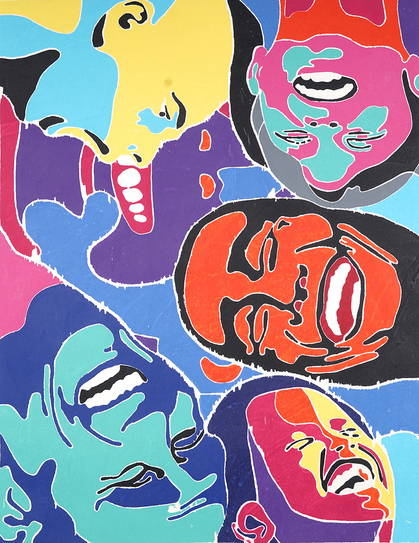-
From Current Issue
-
- Editor’s Letter Fire in the Heart
- Reviews I Gusti Ayu Kadek Murniasih
- Reviews 11th Seoul Mediacity Biennale: “One Escape at a Time”
- Dispatch Networked China
- One on One Monira Al Qadiri on Yukio Mishima
- Essays The rise of independent art spaces in pandemic-era Shanghai
- Features Tuan Andrew Nguyen
- Table of Contents
- Web Exclusives
- Archive
- Subscribe

R
E
V N
E
X
T
Installation view of FANG LIJUN’s “This All Too Human World” at Hanart TZ Gallery, Hong Kong, 2017. Photo by Kitmin Lee. Courtesy Hanart TZ Gallery.
Fang Lijun’s oeuvre has long been intertwined with the narrative of Cynical Realism—a movement fostered by Chinese artists following the Tiananmen Square crackdown, signifying a generation of artists’ conflicted responses to the government’s stifling of open political and creative expression. Fang’s infamous use of gaudy colors, quoting the plasticity of the objects mass-produced in China, as well as his homogenous throngs of anonymous, bald-headed figures encapsulated the disillusionment of many in relation to China’s cultural sensibilities post-1989 and the societal changes evident in the country since. His recent show, “This All Too Human World,” curated by Johnson Chang and presented at Hanart TZ Gallery, didn’t stray too far from the skeptical questioning of the type of era we are living in today, as first sparked by the movement.
Some of Fang’s iconic subjects from past works—the naked infant, doughy faces caught in awkward contortions and hairless heads—remained apparent throughout the set of figurative oil paintings and woodblock prints boasting bold hues and repetitive forms, all dating from 2016-17. These motifs converged to testify to the sustained—if not escalated—sense of anxiety and pain that pervades Chinese contemporary society as it continues to morph at break-neck speeds. While the omnipresent tropes were previously employed to critique the lack of individual expression in the wake of creative ennui and censorship, 20 years on, they still have a place of relevance as tools to question individualism in a mono-organizational society, fraught with rampant consumerism, and as mirrors through which we can evaluate our transformation and ourselves.
Alerting viewers to the artist’s recent move into Pop Art stylistic tendencies was the attention arresting, monumental triptych titled 2016, which welcomed visitors as they entered the main gallery. An intensely colored sea of faces fills the three-part print, appearing to be looking up towards a light source in the space. Their expressions—ranging from pained grimaces, confusion, to possibly even excitement—seemed to express the tension surrounding the future of a rapidly evolving society, looking, ironically, to their government for authoritarian support.
The remaining walls of the main gallery housed pieces more inline with the painterly styles of Fang’s preceding works, including canvases featuring egg-like heads and various animals, predominantly on white or tonal grey backgrounds. One exception was 2013-2017 Summer, which showed five men inquisitively gazing on a baby-like chicken, dangling at the hands of one of the open-mouthed figures, all set against a red background evocative of the Chinese flag. While the canvas was small in size, it packed a politically driven punch, arguably more so than Fang’s larger pieces. In the artist’s opinion, China is experiencing changes that will do away with previously held societal tenets such as identity, equality and personal control. The deformed creature asserts his critical postulation that these values will become unrecognizable in the near future.
Dim lighting in the secondary gallery marked a dramatic departure from the adjacent room. This cleverly crafted use of illumination made the brightly colored woodcut prints hung on the walls sing with their political positions. Emblematic of the artist’s adoption of Pop Art bearings, these works all feature flat planes of color cutouts and laughing faces in a spiraling composition. Evoking a scene of amusement, the prints averred a mocking criticism of the political fray in modern socialist China, which has seemingly embraced capitalism and consumerism, while the state’s tight grip remains.
Another notable and rather ironic use of spot lighting was best exemplified with 2017, wherein a baby floats amid puffs of grey clouds and a crescent of sunlight. The lighting gave the piece an almost ethereal feel—a stark contrast to the surrounding works, offering the exhibit an added brightness, which could be perceived as a glimmer of hope. However, as the curator warned in his statement—the sun’s rays can also burn.
Fang Lijun’s “This All Too Human World” is on view at Hanart TZ Gallery, Hong Kong, until December 2 2017.
To read more of ArtAsiaPacific’s articles, visit our Digital Library.







